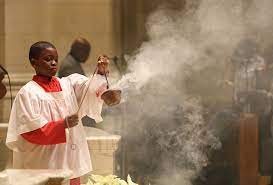The use of incense in the Liturgy
Many of us who are matured Catholics do not know about the use of incense in liturgical celebration.
In today’s edition of our Sunday Rice and Stew (Catholic Catechism), we shall look into the use of incense in the liturgical celebration in the Catholic Church.
Clear View
Incense is an aromatic substance which is obtained from certain resinous trees and largely employed for purposes of religious worship. The word is also used to signify the smoke or perfume arising from incense when burned.
At mass, Benediction and other liturgical services, Priests, and alter servers swing censers that send clouds of incense wafting through the air.
Indeed, there is no sign or symbol in the church that is just for show off, they are all theological truth and not superfluous.
The offering of incense at Mass is an important part of Catholic worship. It is at that moment that our worship on earth becomes connected with the worship of heaven.
Also, the prophecy of Malachi is fulfilled. He spoke the Lord’s words, saying, “From the rising of the sun to its setting, my name is great among the nations; Incense offerings are made to my name everywhere, and a pure offering” (Mal 1:11)
History of Incense in the Liturgy
There is indeed no clear history of when or why the use of incense became part of the liturgy but the practice was dated back to the days of the Old Testament where our fathers in the faith burn incense before God while offering their gifts.
In the book of Exodus 30:1-10 we see the instruction given to Moses by God thus “you shall make an alter to burn incense upon, of acacia wood shall you make it… and Aaron shall burn fragrant incense on it, every morning when he dresses the lamps, he shall burn it and when Aaron sets up the lamps in the evening, he shall burn it, a perpetual incense before the Lord throughout your generations”.
Also from the New Testament passages in Revelation 5:8 also gave an insight to the use of incense thus “when he had taken the scroll, the four living creatures and twenty-four elders fell down before the Lamb, each holding a harp and with golden bowls full of incense, which are the prayers of the Saints.
sponsored
From these two passages, one can see why the church uses incense because incense is identified with the prayers of the saints and also incense is added to the prayers of the saints by an angel, highlighting the mediation of the angels in our worship.
Read More
The Church teaching on Indulgence
Why we use incense at Liturgical celebration
When we use incense at mass it reminds us of Heaven. Been heavenly reminded by the use of incense implies that our worship of God in the Christian Liturgy is divine in origin.
Just as God told Moses to instruct Aaron and other Levites, we see Bishops, Priests, Deacons and mass servers using the thurible at mass too.
The usage of incense adds a sense of Solemnity and mystery to the mass.
According to Rev. Fr. Williams Saunders, the visual imagery of the smoke and smell remind us of the transcendence of the mass which links heaven and earth, and allow us to enter into the presence of God.
The Church teaches us that the main purpose of incensing and the symbolic value of the smoke is that of purification and sanctification.
In the general instruction of the Roman Missal, incense may be used during the entrance procession, at the beginning of mass, to incense the alter, at the procession and proclamation of the Gospel, at the offertory to incense the offerings, alter, priests and the people.
Incense may be used at the elevation of the sacred Host and Chalice of precious Blood after the consecration. The Priest may also incense the crucifix and the Paschal candle.
Also, incense may be used at funeral masses, the Priest at the final commendation may incense the coffin, both as a sign of honour to the body of the deceased which became the temple of the Holy Spirit at Baptism and as a sign of the faithful’s prayers for the deceased rising to God.
May God bless you dearest and the knowledge you received from this teaching. Happy Sunday.




Amen🙏
Amen
Good write up. More of God’s grace and wisdom.
Amen. Thank you so much. I enjoyed the lecture.
Amen
Amen